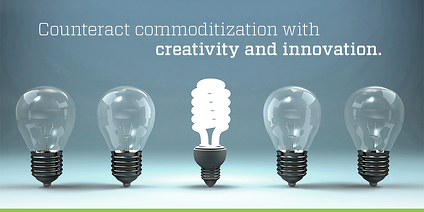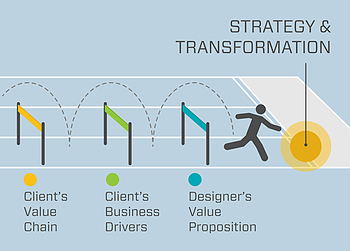In the design business, commoditization is the market movement to undifferentiated price competition and from monopolistic to perfect competition. The key aspect of commoditization is that clients see little distinction between firms, and therefore, more often than not, hire their architect based on price, not the perceived value of service or expertise. Due to the nature of the industry, being a service dependent on the proficiency and expertise of professionals, commoditization is driving structural change. Winning a large percentage of work, especially in the healthcare market, based solely on price should be cause for concern to design firms, for more than likely this is an indication of a slow and painful demise as lower prices drive margin compression and lower quality of work. The industry tends to criticize our clients as being shortsighted for creating these market conditions, yet we should actually be thanking them. If not for these market conditions, most design practices would fail to seek out creative and innovative value propositions. Value propositions that give clients reasons to consider factors other than price.

The incredible constraints placed on health systems today and the volatility of their market force them to seek out value in every transaction. While most of our clients would much prefer to operate in a value-based market, the absence of a compelling differentiating statement and value proposition from their architect will necessarily drive those clients to consider price as their most important criteria when contracting. Many architects would argue that this strategy is shortsighted. That it only considers first-dollar savings without factoring the entire life cycle of the facility and fails to consider operating and staffing efficiencies that may result by hiring a designer focused on providing value.
Architects generally have been either unwilling or unable to invest the resources necessary to understand their clients’ business models and drivers. Many firms respond to the rapid technological advances occurring today by adopting tools then attempting to market those tools as their differentiator. They fail to recognize that technology that is not proprietary is only a differentiator for a very short period, yet they hope and expect that their clients will see it as a compelling, differentiating value proposition. They are puzzled and frustrated when they continue to compete for work based on fee rather than value. They fail to realize that when the market does not react to their firm’s differentiators, either they have not sufficiently articulated a differentiating value proposition, or, from their clients’ perspective, their value proposition fails to deliver “differentiating value”.
 In a commoditized market, rarely are the margins sufficient to allow investment in people or processes, two significant components in creating a differentiating value proposition. Firms that find themselves operating in this market realize how scarce the resources needed to service clients can become. Most architects do not realize that they are well-positioned, and often uniquely qualified, to solve many of the problems that keep their clients up at night. Designers willing to invest in understanding their clients’ business drivers, and look to create processes and services that solve those problems, separate themselves from their competition and create opportunities for both themselves and their clients within a commoditized market. This can significantly reduce the impact a commoditized market has on their practice.
In a commoditized market, rarely are the margins sufficient to allow investment in people or processes, two significant components in creating a differentiating value proposition. Firms that find themselves operating in this market realize how scarce the resources needed to service clients can become. Most architects do not realize that they are well-positioned, and often uniquely qualified, to solve many of the problems that keep their clients up at night. Designers willing to invest in understanding their clients’ business drivers, and look to create processes and services that solve those problems, separate themselves from their competition and create opportunities for both themselves and their clients within a commoditized market. This can significantly reduce the impact a commoditized market has on their practice.
While uncomfortable for many firms, the need to anticipate and react to commoditization forces innovation and creativity, and can create growth opportunities, resulting in stronger, more viable firms. Though many firms recognize when their services are commoditized, they often fail to appreciate the importance of understanding their clients’ value chain in combating these market movements. Another mistake firms often make is relying on our clients to articulate what it is that they need from their architects. Certainly, we must listen to our clients, but most often, innovation will come from designers taking the time to understand clients’ business drivers and pain points, and addressing those in creative, innovative ways. Often times this innovation will require hiring expertise (people) that you do not have, and delivering new or existing services very differently (process) than your current offerings. Unfortunately, this does not come without risk, which is troublesome to a profession that is typically risk adverse.
At Array, we also have experienced the effects of commoditization. The ACA is forcing many serious changes to our client business models and strategies, and is doing so at an incredible pace. Array has invested in hiring data scientists, industrial engineers, and application developers, and has made significant investments to develop a data aggregation and visualization platform all in support of our enhanced value proposition.
While these changes are certainly affecting our practice, they are also creating distinct opportunities, for which we are uniquely qualified, but which require a much different approach to our practice. Design firms must be willing to disrupt their practices to create new services and perspectives, driving the value propositions that clients need, to help move them from fee-based to value-based decisions. Until we articulate and demonstrate those differentiating value propositions, we should expect margins to erode. Unless we seek innovation that our clients recognize as having impact on their value chain, we should anticipate that we will be unable to drive margin growth and attract the expertise necessary for a growing and thriving practice; and we should expect firm ownership and leadership transitions to be extremely difficult. The steps needed to react to commoditized markets do not come without risk, but for those brave firms that embark on the mission, the rewards make it worth the effort.

Array’s journey to address our market issues has been gaining momentum for the last five years. We have looked introspectively at our core design services with an eye toward our clients’ mission and vision. The outcome of that process has been transformational for our practice. We adopted new processes and service offerings, which our clients recognize as creating differentiating value, not only for their design and construction projects, but also for the delivery of healthcare services. We have sought to push our value proposition in both directions.
The launch of Array Advisors consulting group in 2015 was the result of our desire to help clients address strategic initiatives in a comprehensive, integrated manner. Through the inclusion of process, facilities and real estate expertise into their strategic decision-making, healthcare organizations are realizing service improvements, operational efficiencies and quality enhancements that were not available to them before. Our Strategy consulting team provides real estate portfolio optimization services to address our clients’ need to continually assess their physical assets to maximize value. Our Transformational consulting team uses Lean methodologies to help clients identify and transcend both physical and operational current state barriers to the delivery of efficient healthcare services. Our Facility Management consulting services enable our clients to leverage additional value from their design and construction programs through the entire lifecycle of their buildings. These services are a result of our drive to remain relevant in our market, while improving Array’s value proposition to our healthcare clients.
While this journey has resulted in significant changes in our practice, it also has created significant and compelling opportunities that would not have presented themselves but for those annoying adverse market conditions. Out of adversity comes opportunity to those practices willing to invest in understanding their clients’ vision.
Click the button below to learn more about Array Advisors’ value proposition.

